Earth
Madhya Pradesh: Crop Damage Due to Excessive Rain—What Could Be the Solution?
Excessive rains in Madhya Pradesh have destroyed crops across villages like Chirai and Kesli, leaving farmers’ livelihoods at risk. Experts suggest simple solutions like drainage channels and raised-bed sowing to protect fields and build resilience against erratic monsoons.

This year, too, the monsoon in India brought not the usual promise of prosperity but widespread destruction, as it has in recent years. Torrential rains flooded farmlands across several states, washing away livelihoods and submerging the hopes of millions of farmers. Instead of irrigating the fields, the rain turned into an unrelenting deluge. States like Punjab, Maharashtra, Bihar, Uttar Pradesh, and Madhya Pradesh experienced heavy flooding that claimed lives, displaced thousands, and devastated crops — a major blow to the country’s agricultural economy.
When rain becomes a curse
Madhya Pradesh, often called the “Heart of India,” has been particularly affected. Both floods and waterlogging have crippled agriculture. The monsoon began on June 16, and by the end of September, the state had received 119% of its average rainfall — 44.2 inches instead of the expected 37 inches, a 7.2-inch surplus.
In the Bundelkhand region, which spans parts of Madhya Pradesh and Uttar Pradesh, July’s rainfall broke a ten-year record. Sagar district recorded 471 mm, Tikamgarh 416 mm, Damoh 365 mm, Niwari 362 mm, and Chhatarpur 261 mm. The rain persisted through October, flooding villages and turning agricultural land into temporary lakes. Bundelkhand, already known for its fragile ecology and dependence on monsoon rains, saw crops submerged instead of nourished. The result: massive losses of yield and income.
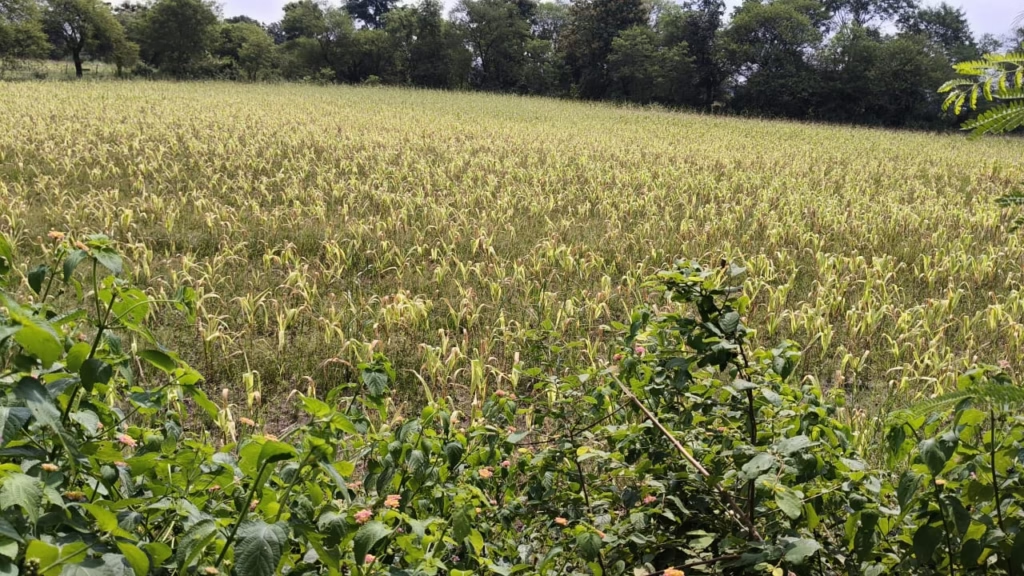
The ground reality: Voices from the fields
A glimpse of the devastation can be seen in the rural belt of Sagar district, where a majority of the population depends on agriculture. Kesli Tehsil, located about 65 km from Sagar city, is known for its fertile soil and green cover. But this year, the sight is heartbreaking — bent paddy stalks, rotting soybean pods, and maize that never reached maturity.
“Even clearing the field costs more than what we’ll earn.” In Chirai village, farmers are counting their losses. Arjun, a natural farming practitioner who owns about 12 acres, says, “Agriculture is the livelihood for all communities here — Brahmin, Thakur, Adivasi, Harijan, and Chadhar. The rains destroyed everyone’s crops. Even the ‘murum’ (gravelly) soil areas are damaged, and crops on black and yellow soil have been wiped out. Until July–August, everything looked promising. Then the rain washed away the crops — and our hopes. The damage is so severe that we won’t even recover the cost of clearing the fields. Farmers will now have to borrow money for the next crop. I fear many small farmers will leave their fields unsown.”

He paused before adding, “A farmer’s income mainly depends on two or three crops a year. Money comes only when we sell them. If the crops are ruined, how will we survive?”
“Our maize only grew three feet”

Sachin Thakur, another farmer from Chirai with 15 acres of land, shares, “I sowed soybean and maize. The soybean was mostly spoiled by the rain, and what remained dried up. The maize plants only grew three to four feet. Some cobs developed, but most plants had none, and the few cobs that did grow had fewer kernels. Nearby villages like Jaruwa, Bamni, Patna, Samnapur, Kukwara, and Mahka are all suffering the same fate.”
“The biodiversity of our fields is dying”
Ramji Thakur, also from Chirai and a member of the Bharatiya Kisan Sangh (Indian Farmers’ Union), explains: “We five brothers cultivate about 40 acres. This year we sowed maize, paddy, and soybean. All have been hit badly. The soybean is completely ruined — we’ll have to plough it back into the soil. Apart from the rain, the biodiversity of our crops and fields is also in danger. The government must take steps for conservation, inspection, and field development to preserve soil fertility and crop purity.”
“Only a little hope left for maize”
In Utkata village, Suresh Kumar Mehra manages 12 acres (four owned, eight leased).
“I planted radish, sponge gourd, pigeon pea (tur), groundnut, and maize. Except for maize on two acres, everything was destroyed by rain and waterlogging. Only the maize gives me a little hope.”

“A fungus ruined our maize”
From Jetpur Doma village, Sitaram Patel says, “I have six acres, and my family has been farming for three generations. This time we grew bottle gourd and tomato, which survived. But maize around us is ruined. About 10% of it got a fungal disease because of waterlogging. The plants couldn’t withstand the rain.”
“Rs 40,000 gone—and nothing to show for it”

Govind Patel from Chauka village detailed his financial losses, “I sowed maize and pigeon pea on five acres. I spent around Rs 40,000 (approx. $480) on seeds, fertilizer, and chemicals. The pigeon pea is completely gone. Only maize might help me recover part of the cost. But most farmers nearby have maize that only grew two to two-and-a-half feet before turning yellow.”
“Only a third of our seeds sprouted”
Ajab Singh, a farmer from Kewlari Kalan, shares, “Here we have small and big farmers, and everyone’s crop is affected. We sowed paddy, soybean, and maize, but because of continuous rain and waterlogging, many seeds didn’t even sprout. In most fields, only about 25–30% of the seeds grew.”
He added that crops in surrounding villages like Kheri, Semra, Ghana, and Idalpur were also submerged.
“In low-lying areas, 90% of crops are gone”

Arvind Bhaiji, another Kesli farmer, says, “The flat and low-lying fields are more damaged, while crops in slightly elevated areas are better. Some crops are 50% damaged, others 70%, and some even 90% ruined. The rain caused root rot, and the urea fertilizer has been washed away. Farmers here have small landholdings and little money to manage rainwater.”
District Farmers’ Union: ‘Satellite surveys can’t see reality’
When contacted, Raghuvir Tomar, district president of the Bharatiya Kisan Sangh, says, “the situation of both crops and farmers is very bad. We are demanding that the government conduct an accurate survey and give compensation.”
He criticized the current assessment methods, “In some places, a satellite survey is being used, but it’s not accurate. It doesn’t show the condition of the kernels or the extent of the rot. The ground reality is much worse.”
Climate Change, adaptation, and farmer-led Solutions
As farmers struggle to rebuild, Akash Chaurasia, a nationally recognized innovator in sustainable agriculture, offers a hopeful path. Known for developing Multi-Layer Farming, Akash believes the situation is not hopeless — it just demands adaptation.

“This imbalance of excessive rain is a form of climate change,” he explains. “It’s a disruption that can destroy ecosystems if farmers don’t adapt. But solutions exist.”
His advice is straightforward and affordable:
1. Build Drainage Channels
“During heavy rain, farmers should dig a two-foot-deep and two-foot-wide drain around the raised boundary (med) of their field. This helps excess water escape into canals or pits. When water collects underground, it recharges groundwater and prevents soil erosion. Fertilizer won’t wash away, and waterlogging will end.”
2. Adopt Raised-Bed (Med) Sowing
“In the Med method, crops are sown four to five inches above the ground. When it rains, the water stays in the drains, not around the crop. This prevents root rot. Farmers can do this with their own labour — no extra money is needed. I’ve used it on my own farm, and our crops stay healthy even in heavy rain.”
Akash believes such simple practices, if widely adopted, could transform India’s vulnerability into resilience.
“If every farmer in waterlogged regions followed these two steps, we could save thousands of acres every year.”
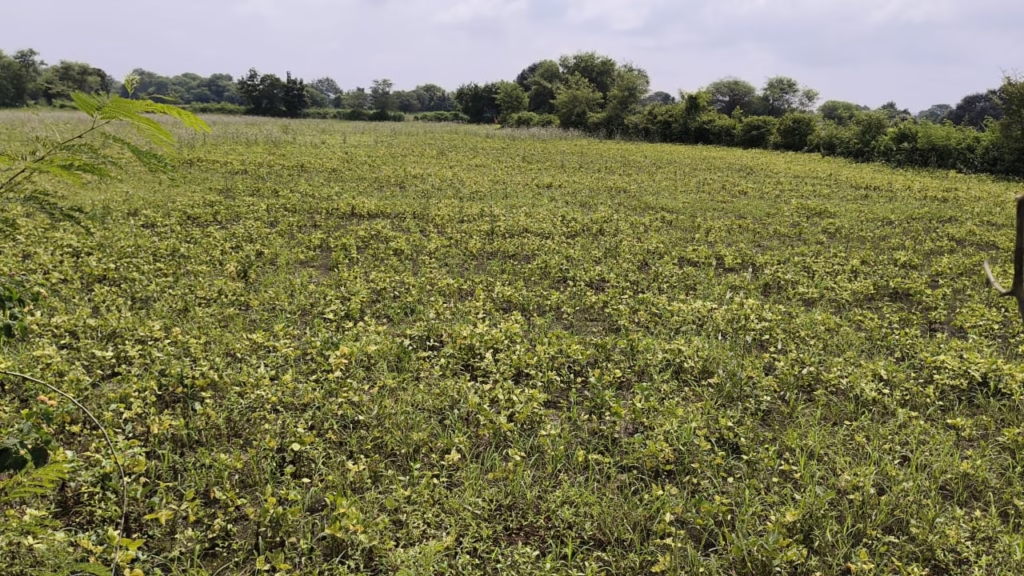
Government Support — And What’s Still Missing
India has several schemes designed to protect farmers from disasters:
- Pradhan Mantri Fasal Bima Yojana (2016): Provides crop insurance and financial assistance during natural calamities.
- Pradhan Mantri Kisan Samman Nidhi Yojana (PM-KISAN, 2019): Offers Rs 6,000 (approx. $72) annually to farmers for basic support.
- Mukhyamantri Kisan Kalyan Yojana (2020): Adds another Rs 6,000 (approx. $72) per year from the state government.
Despite these, many farmers say the support arrives late or doesn’t cover losses. As Arjun pointed out, “We can’t wait months for relief when we have to buy seeds next week.”
Experts argue that while insurance and compensation help recovery, the real solution lies in prevention — teaching farmers low-cost water management, soil conservation, and climate-resilient methods.
Bringing science and policy Together
Agricultural scientists emphasize the importance of integrating climate-adaptive strategies into local farming practices. Soil moisture mapping, satellite-assisted flood prediction, and localized extension services can inform when to sow, which crops to prioritize, and how to manage water in extreme rainfall years.
What the farmers of Bundelkhand need is not just relief but resilience. Drainage systems, raised-bed cultivation, and better soil management can all help farmers cope with erratic rainfall
Bundelkhand’s case demonstrates a broader climate reality: traditional monsoon patterns no longer guarantee stable farming. What worked decades ago may fail today. Farmers, government agencies, and scientific institutions must collaborate to create resilient systems that protect crops, livelihoods, and the environment.
What the farmers of Bundelkhand need is not just relief but resilience. Drainage systems, raised-bed cultivation, and better soil management can all help farmers cope with erratic rainfall. Local governments could play a transformative role by integrating these ideas into training programs, agricultural extension services, and climate adaptation schemes.
The story of this year’s rain in Madhya Pradesh is one of loss — but also of learning. Farmers like Akash Chaurasia show that adaptation begins with awareness and small, practical steps. If those lessons spread across India’s rural heartland, future monsoons might once again bring prosperity, not panic. The monsoon, once India’s lifeline, is now becoming unpredictable under a changing climate. What farmers in Madhya Pradesh need most is not just compensation—but climate-smart solutions that can secure their future harvests.
(The story is part of EdPublica’s Solutions Journalism Initiative)
COP30
Over 832,000 Lives Lost, $4.5 Trillion in Damages, Extreme Weather The “New Normal”: Warns Climate Risk Index
A new report reveals the staggering toll of extreme weather — over 832,000 deaths and $4.5 trillion in losses between 1995 and 2024.

The numbers are stark, and the story they tell is even starker. More than 832,000 people have lost their lives and USD 4.5 trillion in direct economic losses have been recorded worldwide as a result of nearly 9,700 extreme weather events over the past three decades. That is the central finding of the Climate Risk Index (CRI) 2026, released by the environmental think tank Germanwatch at COP30 in Belém, Brazil.
The new report — the most comprehensive edition of the CRI to date — presents what its authors describe as a “mirror to global injustice”: a world where the poorest nations, least responsible for greenhouse gas emissions, continue to suffer the greatest losses.
Global South at the epicentre
According to the analysis, around 40% of the world’s population — more than three billion people — live in the eleven countries most affected by extreme weather events since 1995. These include India (ranked 9th), China (11th), Haiti (5th), and the Philippines (7th) — all nations of the Global South. None of these countries belong to the world’s richest economies, yet they bear the heaviest brunt of climate shocks.
“Heat waves and storms pose the greatest threat to human life when it comes to extreme weather events,” said Laura Schäfer, one of the index’s lead authors, in a statement. “Storms also caused by far the greatest monetary damage, while floods were responsible for the greatest number of people affected.”
In the 30-year period covered, storms alone caused over USD 2.64 trillion in damages, while floods accounted for nearly half of all people affected by disasters. Floods, storms, heat waves, and droughts together formed the deadly quartet responsible for most of the losses — both human and economic.
A decade of unrelenting disasters
From hurricanes that erased Caribbean islands to floods that swept away entire cities, the CRI 2026 paints a grim global mosaic.
At the top of the long-term index is Dominica, a tiny Caribbean island nation that has faced multiple catastrophic hurricanes. In 2017, Hurricane Maria alone caused losses amounting to three times the country’s GDP.
Myanmar ranks second, largely due to Cyclone Nargis (2008), which killed nearly 140,000 people and left deep scars still visible today. Honduras, Libya, Haiti, and Grenada follow, all of which endured either singularly devastating or repeated disasters.
The report notes that countries like Haiti, the Philippines, and India are trapped in cycles of destruction and recovery. “They are hit by floods, heat waves, or storms so regularly that entire regions can hardly recover from one disaster before the next strikes,” explained Vera Künzel, co-author of the index.
India among the top ten
India’s inclusion in the top ten highlights the scale and variety of climate hazards the country faces. Between 1995 and 2024, India endured over 430 major extreme weather events, resulting in more than 80,000 deaths, affecting 1.3 billion people, and inflicting USD 170 billion in damages (inflation-adjusted).
Recurring heat waves, increasingly intense monsoons, and devastating cyclones — from Odisha (1999) to Amphan (2020) — have made India one of the world’s most climate-vulnerable economies. Urban flooding in states like Maharashtra and Gujarat, and glacier-related floods in the Himalayas, have further underscored this fragility.
Even the rich are not spared
While the Global South remains most exposed, the new index shows that climate risks are no longer confined by wealth or borders. The United States (ranked 18th) and European nations such as France (12th) and Italy (16th) appear among the top 30 most affected countries — a reminder that the climate crisis has become universal.
“COP30 must find effective ways to close the global ambition gap”
The authors warn that no country is immune from the accelerating impacts of global warming. The year 2024 was the hottest on record, with global temperatures surpassing 1.5°C above pre-industrial levels for the first time. Scientists estimate that human-caused climate change added 41 extra days of dangerous heat for billions of people last year alone.
“The CRI 2026 results clearly demonstrate that COP30 must find effective ways to close the global ambition gap,” said David Eckstein, another co-author. “Global emissions have to be reduced immediately; otherwise, there is a risk of a rising number of deaths and economic disaster worldwide.”
A call for climate justice
The report urges the world’s wealthier nations to deliver on their long-standing promises of climate finance and loss-and-damage support for developing countries. Despite repeated commitments, funding for adaptation and disaster recovery remains far short of what vulnerable nations need.
Germanwatch estimates that developing countries may require up to USD 1.7 trillion annually by 2050 to address loss and damage caused by climate impacts. Without this support, the gap between rich and poor in climate resilience will only widen.
The CRI 2026 also points to positive developments — notably, a recent International Court of Justice advisory opinion affirming states’ legal duty to prevent and address climate harm, including through finance and reparations. The ruling, the authors note, adds legal and moral weight to the demands for urgent global action.
A warning — and a choice
Ultimately, the report is more than a statistical document; it is a warning. The patterns of destruction it reveals — from hurricanes in the Caribbean to heat waves in Asia — are not anomalies but signs of a “new normal.”
As COP30 negotiators gather in Belém, the message from the data is clear: unless emissions fall sharply and adaptation accelerates, the toll in both human lives and economic costs will keep rising.
“In a warmer world, tropical cyclones are becoming more intense and more destructive,” said Lina Adil, co-author of the index. “Without sustained global support, some nations will face challenges that are simply insurmountable.”
COP30
Brazil Cuts Emissions by 17% in 2024—Biggest Drop in 16 Years, Yet Paris Target Out of Reach
Brazil’s 2024 emissions dropped 16.7% to 2.15 GtCO₂e, led by Amazon deforestation control—the biggest annual fall since 2009—but the country still risks missing its Paris climate goals.

Brazil’s groEmissionsss greenhouse gas emissions fell from 2.576 billion tons of CO₂ equivalent in 2023 to 2.145 billion tons in 2024, the lowest drop since the country’s 17.2% decline in 2009. This turnaround was powered by enforcement against illegal deforestation, reversing a period of lax protections between 2019 and 2022. The net emissions figure—which deducts carbon absorbed by secondary forests and protected areas—dropped even further, down 22% year-on-year, landing at 1.489 billion tons in 2024.
Sectoral Breakdown: Where Emissions Fell and Rose
The land-use sector, mostly deforestation, saw its gross emissions tumble from 1.341 to 0.906 billion tons (32.5% drop)—the largest reduction on record for any sector. This shifted the national emissions profile:
>> Land use change: 42% in 2024, compared to 52% in 2023
>> Agriculture: 29%, up from 24%
>> Energy: 20%, up from 16%
>> Waste: 5%
>> Industrial processes: 4% (both stable)
Emissions in agriculture and energy remained mostly flat, with only waste (up 3.6%) and industry (up 2.8%) recording notable increases.
Deforestation Down, but Not the Whole Story
Enhanced government actions led to a 33% decline in Amazon deforestation emissions and a 41% drop in the Cerrado. Nevertheless, fires not associated with deforestation nearly doubled Brazil’s net deforestation emissions—an emerging risk as climate change fuels extreme drought and wildfires across formerly resilient biomes.
Agriculture, Cattle, and Energy: Stubborn Sources
Brazil’s cattle sector remains the single largest emissions source, responsible for roughly 51% of national total. Efforts to control methane—including increased feedlot use and smaller herds—delivered a marginal 0.2% reduction in herd size and a slight drop in emissions. Nitrous oxide from fertilizers and lime also saw small declines, offsetting overall emission growth. Notably, emissions from energy rose nearly 1% due to record travel and electricity demand; only record ethanol and biodiesel consumption kept fossil CO₂ in check.
Paris Pledge Still Out of Sight
Despite the historic emissions drop, Brazil is projected to end 2025 with net emissions of 1.44 billion tons—9% above its target under the Paris Agreement of 1.32 billion tons. While deforestation is falling, rising emissions from energy, agriculture, waste, and industry threaten to undermine overall climate progress. Experts emphasize that broader emission cuts, especially in fossil energy, are urgently needed for Brazil to have a chance at meeting its 2030 target (1.2 billion tons).
Brazil’s 2024 emissions breakthrough underscores the pivotal impact of deforestation control on the country’s climate footprint. Yet, absent deeper reforms in agriculture, waste, and especially energy, Brazil’s Paris goals may remain out of reach—a clear signal for policymakers ahead of COP30.
Earth
India and China to Peak Coal Emissions by 2030 — and India’s Data Proves It’s Economically Inevitable
New analysis finds China, India, and Indonesia—the world’s top coal users—can peak power-sector emissions by 2030, marking a global climate turning point.
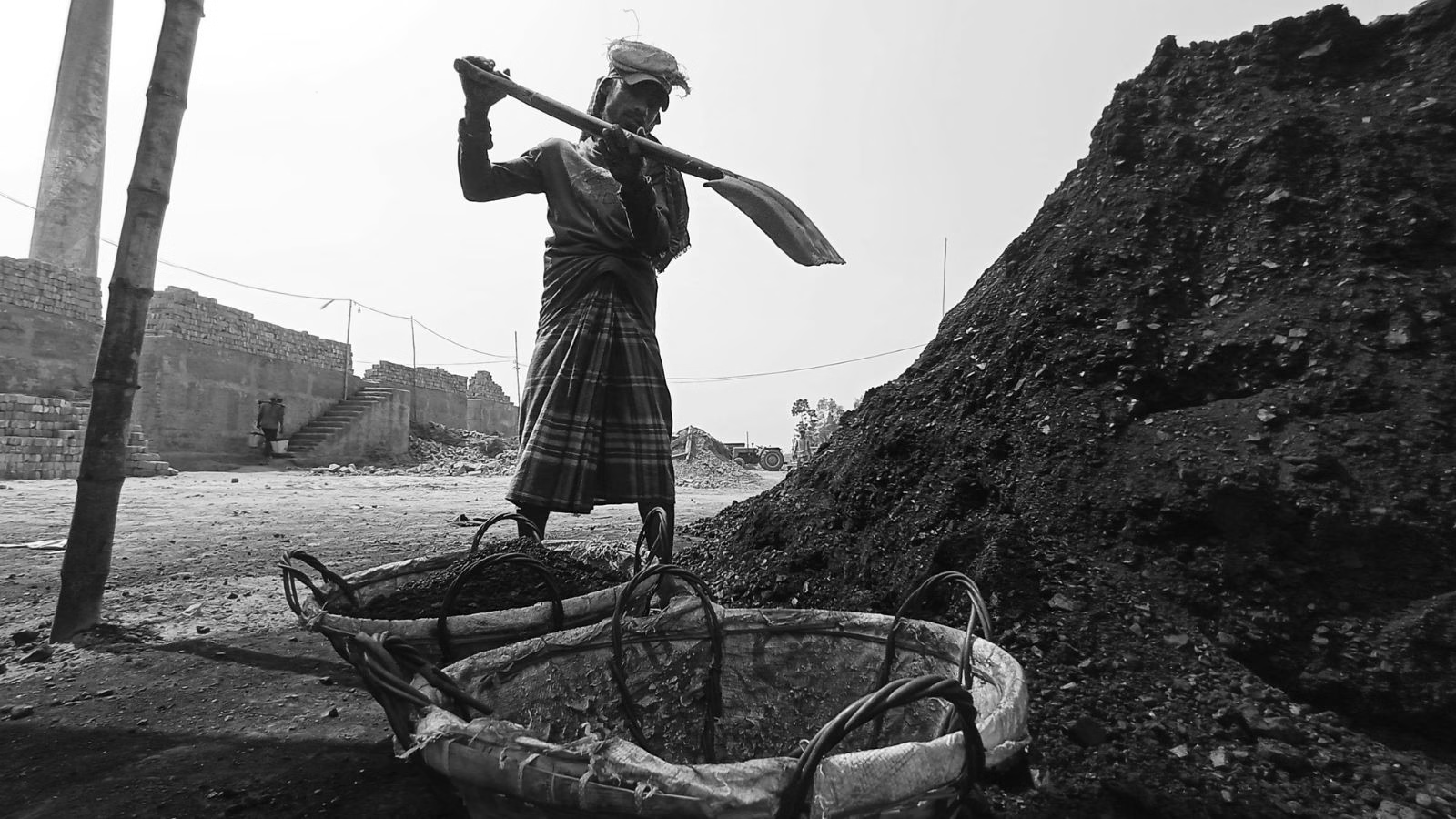
In what could mark a historic global energy shift, new analysis from the Centre for Research on Energy and Clean Air (CREA) reveals that the world’s three largest coal growth markets, China, India, and Indonesia, are on track to peak their power sector emissions by 2030. Together, these nations accounted for a staggering 73% of global coal consumption in 2024, making this potential turnaround a defining moment in the fight against climate change
China: Clean Energy Outpaces Demand
China has already reached a milestone that once seemed improbable: clean energy growth has outpaced the rise in electricity demand, leading to a fall in coal power emissions since early 2024
In 2024 alone, the country added 277 GW of solar capacity and 80 GW of wind, with an additional 212 GW of solar in just the first half of 2025. “Since I announced China’s goals for carbon peaking and carbon neutrality five years ago, China has built the world’s largest and fastest-growing renewable energy system,” President Xi Jinping declared earlier this year.
If current trends continue, China’s coal use may never return to previous highs. But sustaining this progress depends on meeting its 2035 clean energy targets and avoiding a slowdown in installations.
“China has already added enough new clean electricity generation to cover all new demand growth, and power sector coal use and emissions have been falling since 2024 as a result,” said Lauri Myllyvirta, CREA’s Lead Analyst, in the report.
India: Rapid Clean Energy Expansion Takes Off
India’s clean electricity boom, once stalled, has roared to life. In 2024, the country added a record 29 GW of non-fossil capacity, and by mid-2025, that pace had surged by 69% year-on-year.
With Prime Minister Narendra Modi’s 500 GW clean power target by 2030, India is already more than halfway there. The nation’s growing domestic solar manufacturing base—118 GW of module capacity and 27 GW of solar cells—is transforming it into a global solar hub.
“Meeting India’s 500 GW non-fossil power capacity target could peak coal power before 2030,” said Manoj Kumar, CREA Analyst. “Strengthening grid flexibility, storage, and transmission will be key to sustaining this momentum.”
India’s Coal Economics Have Flipped
A new report from Ember (October 2025) adds powerful economic validation to CREA’s projection.
Titled “Adding coal beyond the National Electricity Plan 2032 targets is uneconomical for India,” Ember’s findings confirm that building more coal plants is no longer cost-effective or necessary.
Ember’s least-cost operations model shows that if India meets its National Electricity Plan (NEP) 2032 targets for renewables and storage:
- 10% of new coal units built after FY2024–25 will be completely unutilised by 2031–32
- 25% of the coal fleet will be heavily underutilised
- Coal-based electricity will become 25% more expensive by 2031–32 as utilisation drops
“Building coal beyond the current pipeline is neither necessary nor economical for the country,” said Neshwin Rodrigues, Senior Energy Analyst at Ember.
Ember’s study aligns with CREA’s broader conclusion — India’s clean energy growth is not only sufficient to meet new demand but also the cheapest and most reliable path forward.
Indonesia: Big Solar Vision vs. Fossil Reality
Indonesia’s new president Prabowo Subianto has laid out a bold plan for 100 GW of solar capacity and a 100% renewable power system by 2035. If fully realized, this initiative alone could cause coal power to peak by 2030.
However, Indonesia’s official power plan—the RUPTL 2025–34—still leans heavily on new coal and gas plants. CREA’s analysis warns that without strong oversight and power market reforms, Indonesia’s solar revolution could stall.
“The real opportunity lies in translating this vision into a concrete delivery roadmap that positions clean energy to dominate new capacity additions,” said Katherine Hasan, CREA Analyst.
The Economics of Change
Across all three nations, clean energy’s economic edge is becoming undeniable.
The cost of solar panels has dropped 60% since 2022, while battery storage prices fell 50% between 2022 and 2024. In China, clean energy industries now make up over 10% of GDP, fuelling jobs and innovation. India’s solar bids are now cheaper than coal tariffs, and Indonesia’s strong sunlight potential could soon make solar the most cost-effective option for households.
CREA’s report also highlights that these clean energy drives align with national priorities: energy independence, industrial growth, and improved air quality.
A Common Threat: Coal’s Last Stand
Despite rapid progress, the report warns of a looming obstacle—new coal projects. China currently has 230 GW of coal-fired power under construction, and India plans 100 GW more by 2035. “Unchecked coal power expansion risks creating powerful vested interests that could delay the energy transition,” Myllyvirta cautioned. A rapid phase-down post-2030, he added, could cut emissions equivalent to India’s entire 2019 CO2 output.
A Turning Point for BRICS and the Planet
If successful, China, India, and Indonesia would join Brazil, South Africa, the UAE, and Ethiopia—other BRICS members that have already peaked their power emissions—transforming the bloc into an unexpected climate leader.
But the next few years are pivotal. Whether these nations sustain their clean energy momentum or fall back into fossil dependence could determine the world’s ability to meet the goals of the Paris Agreement.
As CREA concludes in the report, the road to peaking emissions is now open—what remains is the political will to walk it.
-

 Space & Physics6 months ago
Space & Physics6 months agoIs Time Travel Possible? Exploring the Science Behind the Concept
-

 Know The Scientist6 months ago
Know The Scientist6 months agoNarlikar – the rare Indian scientist who penned short stories
-

 Know The Scientist5 months ago
Know The Scientist5 months agoRemembering S.N. Bose, the underrated maestro in quantum physics
-

 Space & Physics3 months ago
Space & Physics3 months agoJoint NASA-ISRO radar satellite is the most powerful built to date
-

 Society5 months ago
Society5 months agoAxiom-4 will see an Indian astronaut depart for outer space after 41 years
-

 Society5 months ago
Society5 months agoShukla is now India’s first astronaut in decades to visit outer space
-

 Society5 months ago
Society5 months agoWhy the Arts Matter As Much As Science or Math
-

 Earth5 months ago
Earth5 months agoWorld Environment Day 2025: “Beating plastic pollution”





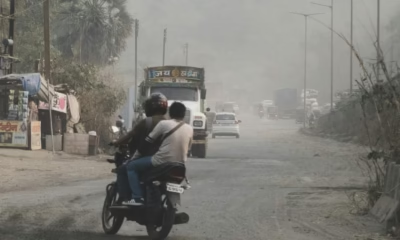

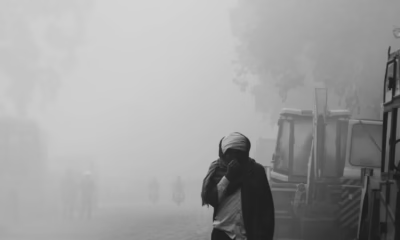

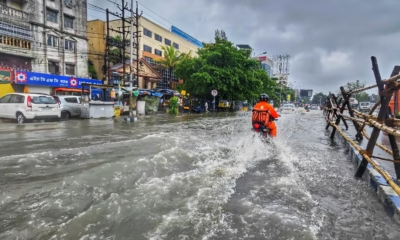













Pingback: Global Warming Supercharges India’s Monsoon, Drives Rainfall Extremes: New Analysis finds - EdPublica